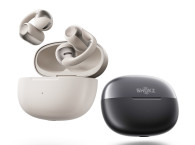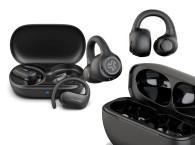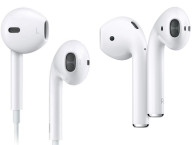If you're one of those enthusiasts of $1,000+ custom-molded wired IEMs just for music listening what I'm about to discuss will be of no interest. Those IEMs offer a whole other level of sound quality. And the reason starts with the requirement of occlusion or the need to isolate our hearing from the outside world when IEMs were originally designed for performing musicians that use those on stage.
Of course, many were fascinated with the resulting immersiveness and unique qualities of the whole IEM experience, leading to an enthusiasts’ market that continues to grow, and to inspire manufacturers to design IEMs with 21 balanced armature drivers per side.
While that market continues to grow (and to generate a level of investment that rivals that of other luxury markets), it's really a very small group compared with the hundreds of millions that today use true wireless stereo (TWS) earbuds. Ironically, almost two-thirds of those many millions TWS users are not satisfied with their experience, and only tolerate using them for short periods of time. Since the replacement cycle for these relatively cheap products is short, many millions are also open to trying something different as well. As highlighted in my recent "Earbuds and Hearables State of the Industry" report in audioXpress April 2024, sales of TWS earbuds are estimated to be between 250 to 350 million units per year. That's more units PER DAY, than the whole high-end IEM market sells PER YEAR.

Can’t Get No...
If you're one of those millions of people who have not yet found satisfaction when wearing any type of headphones outside the home, particularly with AirPods (or even old-fashioned wired EarPods) because placing things in your ears causes pain, discomfort, or simply anxiety - because you cannot stand being isolated from the outside world - then this is the reason why I'm writing this editorial.
Apparently, there's more people identifying themselves in this "not satisfied" group than all current earbuds users out there. Even when getting used to social protocols of wearing earbuds in public and getting used to in-ears with ANC and effective transparency modes, long hours of usage remain a challenge that the industry has already identified, when market research indicated Comfort as one of the primary drivers for selection of replacement earbuds.
The thing is, before we can even progress to the hearables use cases, we need to sort out these human objections to wearing transducers in, on, or outside our ears. And I believe those will always be the majority of people, no matter how much they get familiarized with the standard TWS earbuds we have today.
I have previously addressed the form factors the industry adopted, either "loose-fit" or occluded in-ears, in several articles. That was an evolutionary process that resulted from the transition from mass-produced earbuds such as the wired Apple EarPods to TWS earbuds with effective ANC, like the AirPods Pro. Even Apple's own research indicated that they needed to perfect the loose-fit form factor (the current AirPods third generation), and keep it as an alternative to the in-ear occluded design of the AirPods Pro - needed for ANC.
Something the industry followed and perfected. Inside the - now forgotten - what I found most interesting was the design itself with a big round external surface that almost closed the ear canal, and the loose-fit design on the inside. For the Surface Earbuds design, Microsoft combined custom-designed 13.6mm dynamic drivers with two advanced microphones in each earbud to block out background noise. Since they didn't go inside the ear and did not completely block the ear canal, it was clear that this was ahead of its time.
Unfortunately, Microsoft retired that product without giving us an opportunity to understand why - much like they did with their much-touted Cortana voice assistant efforts. As I also wrote back in 2019, "While it is easy to acknowledge that you can get much better quality sound with plugged in-ears, the trade-off from the occlusion effect and the fatigue (and pain, for some people) that results from having something inside the ear canals has not received enough consideration. Apple is selling massive amounts of AirPods, for many reasons, including because they are much more comfortable to wear for most people. And it's not as if Apple didn't consider the issue carefully, as a quick look at the many Apple patents in this domain reveals."
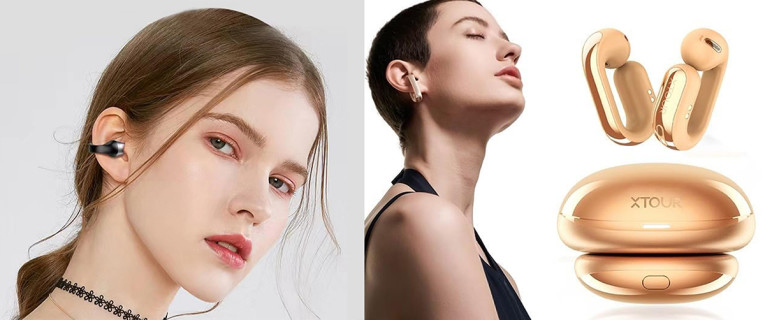
From Loose to Air Conduction
Currently what the industry is commonly referring to as “open-ear" is associated with Air Conduction, a term that is frequently mentioned associated to audiometry techniques in contrast with bone conduction.
Back in 2016, I encountered a company that promoted the concept of "Open Guided Sound" (OGS - ogsearphone.com), which was a very basic "channeling" of the sound from a dynamic driver sitting "outside" the ear, ending in a short acoustic tube to get the sound closer to the auditory canal. OGS was (and still is) promoted as an effective way to allow "earphone wearers" to enjoy quality sound while remaining aware of sounds in their surrounding environment. This is also characterized as "open soundfield."
There are other approaches to open-ear that I liked, and I have mentioned the case of Auricle, a Danish pioneer in cartilage conduction that perfected a very effective way to stay closer to the ear. The company is now expanding that original design and looking for ODM partners to explore true wireless stereo options.
But while also touting “open-ear," today's air conduction is a much more elaborate technique that allows directing (steering) sound to the ear, and (ideally) the ear canal using signal processing beamforming - eventually even using ultra-sound modulation - to generate an effective soundfield similar to headphones, without even touching the ear. Apple is using this concept with some degree of success on the audio system for its Vision Pro . Still, not enough to replace the full experience with the AirPods Pro, which Apple also recommends for immersive content. Many companies are exploring air conduction also for glasses frames, to create a more convincing soundfield and avoid the dreaded sound spill - so far with very unconvincing results (and I tried a few).
The more effective approach - and the one that the market is enthusiastically exploring - is to place a "loose-fit" form factor "hanging" somewhere in the outer ear, ideally inside the concha and as close as possible to the external auditory canal. Since air conduction uses "beaming" achieved in different ways, the aiming is critical to the fidelity of the signal and the amount of bass that is perceived by the wearer.
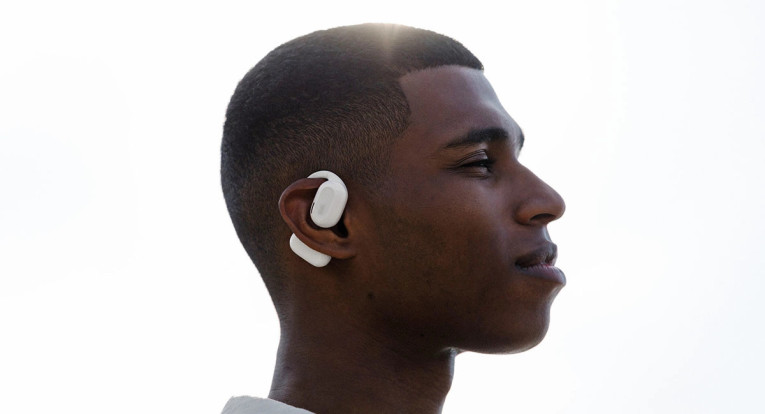
Earhook Open Ears
The first method that was attempted to create a stable open-ear design was the wrap-around-the-ear approach. An earhook is an effective way to suspend the transducer section above the ear, normally pressuring against the concha and any of the ear cartilages, with an opening or duct aiming at the canal. This more or less predictable position enables the beam to be optimized to improve both intelligibility and fidelity of the perceived signal (where bass-enhancement is still needed).
I tried almost every single model I could find at CES and IFA 2023 and all the other shows where products of this type are introduced, right until CES 2024. This year, I noticed that most companies had already received negative feedback from users, since I noticed a defensive approach, and many new models already claiming "improved bass" and even noise-reduction.
These open-ear designs using air conduction principles have been explored in models from different brands and seem to be particularly popular in China. In the US, Bose briefly explored the concept with the Bose Sport Open Earbuds, optimized for sports, fitness, and wellness, and soon discontinued. We can still find similar designs from Cleer Audio, OneOdio, and others competing directly with the first-generation Oladance OWS - launched in 2022 after a successful campaign on Kickstarter, and updated later as OWS 2. Anyone looking at these designs will also notice some similarities with the Shokz bone conduction devices, and the recently announced Shokz OpenFit TWS around the ear, open ear TWS design - another attempt at air conduction.

So, in that regard, Oladance can be considered a leading air conduction vendor, given that it has remained focused on the open-ear concept and has been perfecting the technology with each generation. The OWS Pro are effectively a new and more ambitious approach, starting with the completely different - and highly visible – form factor that reminds us of the Olive Max hearing assist product, from Olive Union.
After trying all these models, I was not impressed and definitely would not recommend those to anyone. Not only was the audio too "thin" and weak, but any attempt to compensate for the lack of volume would cause an immediate drastic increase in distortion. Of course, I normally tried them in the noisy environments of trade shows, but that's actually less noisy than what a user would experience outside the home.
In any case, it seems air conduction - combined with sophisticated audio processing platforms and new-generation transducers - could be going somewhere. The difference is that some companies have managed to generate a more effective "air conduction" beam than others - and this is undoubtedly a combination of a better driver, acoustic design, and digital signal processing. In my IFA 2023 report for The Audio Voice, I mentioned Attitud, a French company focused on open-ear concepts. Its AirDC technology is based on directional air conduction and offers a clear and very natural sound. The best demo of the concept I tried so far. Unfortunately, the company seems to have vanished for now, or they are working on a new website.
I also had a preview of the interesting JBL Soundgear Sense true wireless open-ear earbuds. Harman specifically talks about "JBL OpenSound Technology with air conduction," and these are the company's second attempt in this form factor. The JBL Soundgear Sense combines custom 16.2mm drivers and a bass-enhancing algorithm to improve the open-ear sound quality. A unique and well-thought-out design aspect is that the ear-hooks offer rotation and size adjustments. This not only improves long-term comfort but also helps optimize the air conduction beaming without obstructing the ear canal. According to Harman, these also use the unique design and large shape to reduce sound leakage and protect privacy. The JBL Soundgear Sense is also the first design of the type to promise Bluetooth LE audio support with an upcoming firmware update.
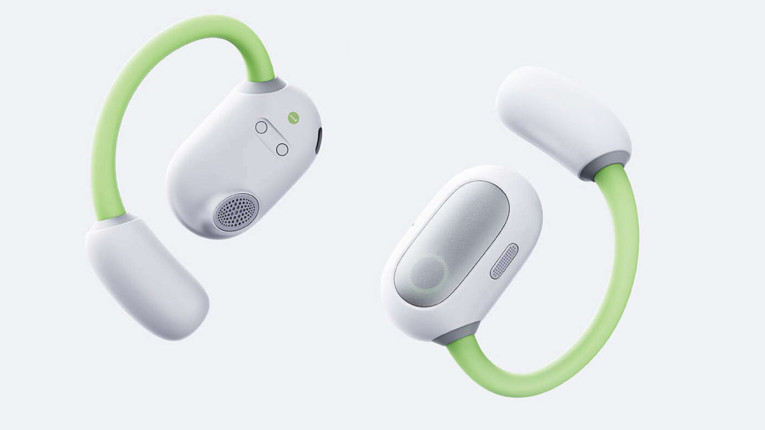
The Baseus Eli Sport 1 Open-Ear TWS Earbuds are the latest design of this type we have seen announced. These are directly aimed at the "bone conduction" adopters that are looking for a less annoying way to enjoy music while jogging or doing any sports - "without the difficulty of pushing an earbud directly into the ear canal." The company highlights the "guided air conduction driver" that helps "create a grand soundscape" also enhanced with a Deep Bass Boost Algorithm and 16.2mm Ultra-Large Driver. Another interesting aspect in this affordable product from Baseus (a brand more recognizable for its excellent range of chargers and adapters) is the advanced wind noise reduction algorithm that the company says is effective to "mitigate background noise and enhance vocal clarity."
The Baseus is an interesting example for its affordable price, showing that the industry is trying to see what it is possible to do with basic DSP to improve the air conduction experience, even if it's just for basic things such as noise reduction during calls. All these designs have very good specifications in terms of battery autonomy compared to conventional TWS earbuds. The designs normally have space for larger batteries. On the downside, many manufacturers struggle with the charging cradles inside the case, which need to accommodate the large earhooks and frequently fail to provide proper contact for charging. Samples I have tried wouldn't even start because they had been misplaced inside the case when they were packaged at the factory.

Ear-Rings and Open Earbuds
The latest and more significant evolution in the open-ear concept - using air conduction principles - is a completely different form factor that more resembles earrings - or ear-rings. In my recent post , which was one of our top-trending articles for a whole month, I addressed the fact that Bose has actually been working on this new design for some time.
But so was Huawei and a bunch of other lesser-known companies, many of which have likely become aware of ODM efforts. Amazon shows a few examples available for purchase (not recommended), and at CES there were others doing unconvincing demonstrations.
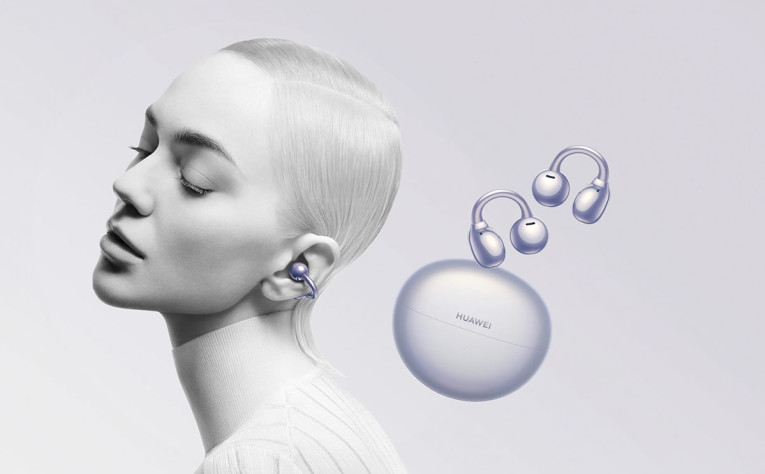
The result of an intense research effort to achieve the most effective approach for an open-ear design, Bose introduced the Ultra Open Earbuds as a completely new form factor and as "a breakthrough audio wearable." The Bose Ultra Open Earbuds use air conduction to feed audio to the inside of the ear, while resting on the lower ear.
The innovative design folds around the lower part of the ear, preferably holding to the antitragus, with an air conduction transducer - a tiny dipole - seating inside the concha. The electronics and battery are rolled-up tightly in a barrel behind the auricle to fit and hold. Compared to anything else that Bose tried before in open-ear designs (usually too bulky and prominent), the Bose Ultra Open Earbuds look good - a fusion of earring and a cuff earpiece.
The flexible fold around the ear is coated in super-soft silicone connecting the speaker to the battery barrel, so it provides a light grip to keep the earbuds secure on almost any ear. To make this concept work where many others have failed, Bose managed to get the air conduction transducer and vent to sit inside the concha, which helps deliver a wider range of lower frequencies that normally are missing in designs that sit outside. This also allows using the available signal processing to not only balance the response and extend the bass, but to deliver an enhanced spatial perception that better matches the open-ear experience. That's where Bose applied its Immersive Audio algorithm to create the impression that the music is being played in the room around the user, instead of through the earbuds.
More importantly, audio is enjoyable at safe levels and allows for a great level of awareness, which is ideal in the wearable category. As Bose found out, this specific "ring" design doesn't interfere much with personal jewelry and piercings in the ear - which is another relevant concern. Bose made sure to try out the concept extensively before making the Ultra Open Earbuds commercially available.

I got a pair as soon as they were available, and I can confirm how effective they are. The design should provide superior comfort for most people and for all-day wear, while being practical enough to allow for soft fitness activities. In my ears, they gripped well, and I could immediately forget I had them on. But as I later found out, 1 out of 3 people I asked to try these couldn't place them correctly on either side, or one of the sides. Ear anatomy is in fact a problem for these designs and there's no universal fit. But I guess that 2 out of 3 is not bad.
The sound was the most positive thing. I asked those users who were able to fit the Ultra Open Earbuds correctly - some of which were familiar with in-ears and loose-fit earbuds - and all liked the sound, even before we made any volume or other adjustments. All seemed pleased with how good the sound was, while being able to have a conversation and hear everything else normally. That's what's great for everyone. I also could tell there was not too much sound spill to the outside, at reasonable volume.
Now, for my personal tests, and using more rigorous criteria, I have to say that the sound was just "good enough" for me in indoor public spaces like the airport. As soon as there's wind, or loud noises (inside the plane) they are useless. As I suspected, when I tried them during a flight instead of the AirPods Pro, I could hardly hear the music. Increasing the volume didn't help - it just made the treble distort painfully. At home, they are superb - but I guess that's not the main intention here (although I found them great to watch TV).
I needed to try the Bose app and the OpenAudio technology adjustments at home and while walking outside in the park, to correctly assess the difference. And I was surprised at how the earbuds can play rich, full audio range privately. Slightly adjusting the angle in the ears makes some difference, but they tend to stay where I found them to aim better inside the ears. OpenAudio makes it sound like we hear sound from outside the ears ("speakers in a room" would be a bit too much - it's more like listening to headphones without the weight and pressure on the ears). For me, the default, neutral response was the best - I only tried standard AAC streaming from my iPhone, from different sources. Bass boost or treble boost was not needed. Everyone I asked to try the Ultra Open Earbuds also found the default bass impressive. At higher volume, the "Treble Reducer" option is actually best for some music genres.
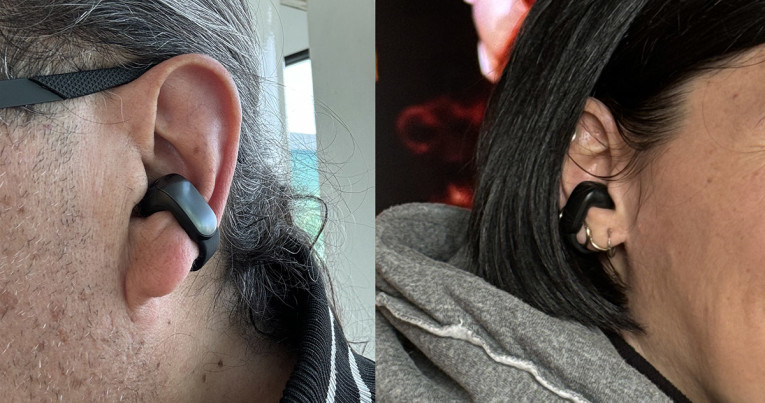
The Immersive Audio processing is effective when we listen to that type of content - but I always prefer the OFF position even with supposedly "Spatial Audio" music mixes but that's me because I only like to hear Dolby Atmos or other immersive formats with actual speakers. The head-tracking works and impresses positively - but the majority of people I asked don't understand the concept - or don't care. I truly believe that Bose should have used the DSP budget available in the platform for noise reduction and adjustment compensation - but the marketing hype about "immersive" is just more powerful at the moment.
Overall, my experience with the Bose Ultra Open Earbuds was very satisfying once you understand their limitations. Don't know if all users do, particularly when they discover how difficult it is to make a call on the streets of NY. As I wrote, air conduction is a superior approach to bone conduction on its own, but it needs to be matched with a design like the Ultra Open Earbuds to meet the expectations of users who want to feel the music and not just listen to podcasts. The Ultra Open Earbuds deliver a natural awareness that can be much better for most users than the alternative Transparent/Aware models from ANC designs. But with Adaptive ANC and new MEMS transducers with active vents, that is also changing.
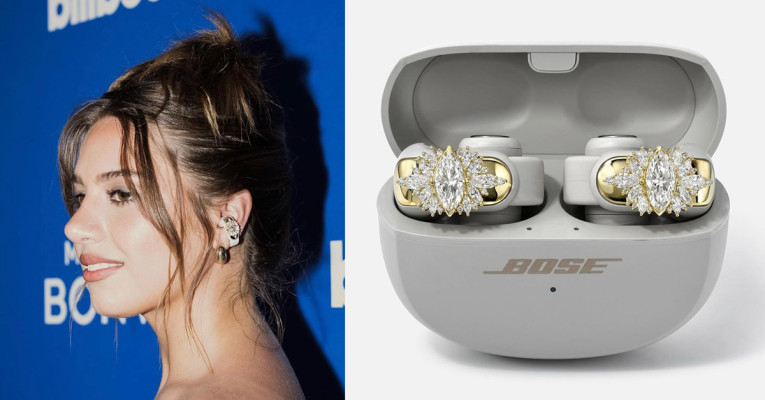
The Ultra Open Earbuds are available for $299 (plus tax). That is steep for the market, particularly considering that places them in the range of the leading ANC earbuds. No wonder Bose is trying to market these as "jewelry," creating even more expensive customized models, and appealing to fashion senses. I sincerely hope that Bose will consider perfecting this design in the near future. These could actually be a great design if I had to listen to Auracast streams and public announcements in public spaces.
Of course, there is competition. The Huawei FreeClip C-bridge, open-ear design is a more sophisticated implementation of this form factor, promising to use DSP and even AI to improve the user experience - including adaptive independent left/right buds (these have a symmetric design). The FreeClip have a 10.8mm dual-magnet high-sensitivity driver, and the processing minimizes sound leakage by using "a sophisticated reverse sound waves system built inside the acoustic ball," for a private listening experience. For voice calls, there is a multi-channel deep neural network (DNN) algorithm to effectively pick out voices from ambient noises. I cannot say much more since I could not try it to the extent I have used the Bose Ultra Open Earbuds, which I am keeping.
My final thought about air conduction is similar to what I wrote about loose-fit designs: While it makes the whole signal processing more complicated, it could actually show some benefits in augmented hearing applications and hearables. And now we have powerful edge-AI platforms to make open-ear air condition designs much better. aX
This article was originally published in The Audio Voice newsletter, (#461), March 21, 2024.




